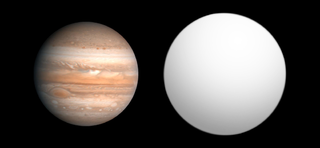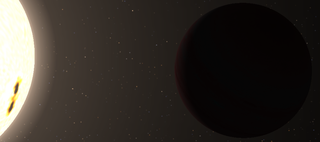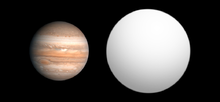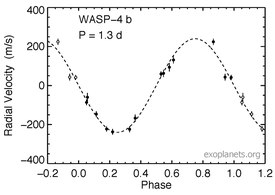
XO-3b is an exoplanet with about 11.79 times the mass of Jupiter, and it orbits its parent star in about 3.2 days. The radius of this object is 1.217 times that of Jupiter. Astronomers announced their discovery on May 30, 2007, at the American Astronomical Society in Honolulu, Hawaii. Its discovery is attributed to the combined effort of amateur and professional astronomers working together on the XO Project using a telescope located on the Haleakala summit in Hawaii.

WASP-5b is an extrasolar planet orbiting the star WASP-5 located approximately 1000 light-years away in the constellation Phoenix. The planet's mass and radius indicate that it is a gas giant with a similar bulk composition to Jupiter. The small orbital distance of WASP-5 b around its star mean it belongs to a class of planets known as hot Jupiters. The equilibrium planetary temperature would be 1717 K, but measured in 2015 temperature was still much higher at 2500±100 K. Dayside temperature measured in 2020 was 2000±90 K.
WASP-11/HAT-P-10 is a binary star. It is a primary main-sequence orange dwarf star. Secondary is M-dwarf with a projected separation of 42 AU. The system is located about 424 light-years away in the constellation Aries.

WASP-4 is a G-type main-sequence star approximately 891 light-years away in the constellation of Phoenix. Despite its advanced age, the star is rotating rapidly, being spun up by the tides raised by a giant planet on a close orbit.
WASP-18 is a magnitude 9 star located 400 light-years away in the Phoenix constellation of the southern hemisphere. It has a mass of 1.29 solar masses.

HAT-P-14b, officially named Sissi also known as WASP-27b, is an extrasolar planet located approximately 224.2 ± 0.6 parsecs (731.2 ± 2.0 ly) away in the constellation of Hercules, orbiting the 10th magnitude F-type main-sequence star HAT-P-14. This planet was discovered in 2010 by the HATNet Project using the transit method. It was independently detected by the SuperWASP project.
WASP-33b is an extrasolar planet orbiting the star HD 15082. It was the first planet discovered to orbit a Delta Scuti variable star. With a semimajor axis of 0.026 AU and a mass likely greater than Jupiter's, it belongs to the hot Jupiter class of planets.
KELT-18b is a hot Jupiter orbiting the F-type main sequence star KELT-18 approximately 1,058 light years away in the northern circumpolar constellation Ursa Major. The planet was discovered using the transit method, and was announced in June 2017.
HAT-P-30, also known as WASP-51, is the primary of a binary star system about 700 light-years away. It is a G-type main-sequence star. HAT-P-30 has a similar concentration of heavy elements compared to the Sun.
WASP-78, is a single F-type main-sequence star about 2500 light-years away. It is likely to be younger than the Sun at 3.4+1.5
−0.8 billion years. WASP-78 is depleted in heavy elements, having a 45% concentration of iron compared to the Sun.
BD-07 436, also known as WASP-77 since 2012, is a binary star system about 344 light-years away. The star's components appears to have a different age, with the secondary older than 9 billion years, while the primary's age is 5 billion years. The BD-07 436 system's concentration of heavy elements is similar to the Sun. Its stars display moderate chromospheric activity, including x-ray flares.
WASP-72 is the primary of a binary star system. It is an F7 class dwarf star, with an internal structure just on the verge of the Kraft break. It is orbited by a planet WASP-72b. The age of WASP-72 is younger than the Sun at 3.55±0.82 billion years.
WASP-64 is a star about 1200 light-years away. It is a G7 class main-sequence star, orbited by a planet WASP-64b. It is younger than the Sun at 3.6±1.6 billion years, and it has a metal abundance similar to the Sun. The star is rotating rapidly, being spun up by the giant planet in a close orbit.
WASP-63 or Kosjenka, also known as CD-38 2551, is a single star with an exoplanetary companion in the southern constellation of Columba. It is too faint to be visible with the naked eye, having an apparent visual magnitude of 11.1. The distance to this system is approximately 942 light-years based on parallax measurements, but it is drifting closer with a radial velocity of −24 km/s.





